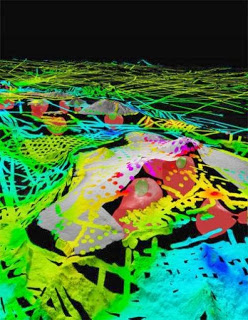
A recent study by researchers at the University of Hawaii — Manoa (UHM) School of Ocean and Earth Science and Technology (SOEST) and the University of Rhode Island (URI) changes the understanding of how the Hawaiian Islands formed. Scientists have determined that it is the eruptions of lava on the surface, extrusion, which grow Hawaiian volcanoes, rather than internal emplacement of magma, as was previously thought.
Before this work, most scientists thought that Hawaiian volcanoes grew primarily internally — by magma intruding into rock and solidifying before it reaches the surface. While this type of growth does occur, along Kilauea’s East Rift Zone (ERZ), for example, it does not appear to be representative of the overall history of how the Hawaiian Islands formed. Previous estimates of the internal-to-extrusive ratios (internally emplaced magma versus extrusive lava flow) were based on observations over a very short time frame, in the geologic sense.
Ashton Flinders (M.S. from UHM), lead author and graduate student at URI, and colleagues compiled historical land-based gravity surveys with more recent surveys on the Big Island of Hawaii (in partnership with Jim Kauahikaua of the U.S. Geological Survey — Hawaii Volcano Observatory) and Kauai, along with marine surveys from the National Geophysical Data Center and from the UH R/V Kilo Moana. These types of data sets allow scientists to infer processes that have taken place over longer time periods.
“The discrepancy we see between our estimate and these past estimates emphasizes that the short term processes we currently see in Hawaii (which tend to be more intrusive) do not represent the predominant character of their volcanic activity,” said Flinders.
“This could imply that over the long-term, Kilauea’s ERZ will see less seismic activity and more eruptive activity that previously thought. The 3-decade-old eruption along Kilauea’s ERZ could last for many, many more decades to come,” said Dr. Garrett Ito, Professor of Geology and Geophysics at UHM and co-author.
“I think one of the more interesting possible implications is how the intrusive-to-extrusive ratio impacts the stability of the volcano’s flank. Collapses occur over a range of scales from as large as the whole flank of a volcano, to bench collapses on the south coast of Big Island, to small rock falls. ” said Flinders. Intrusive magma is more dense and structurally stronger than lava flows. “If the bulk of the islands are made from these weak extrusive flows then this would account for some of the collapses that have been documented, but this is mainly just speculation as of now.”
The authors hope this new density model can be used as a starting point for further crustal studies in the Hawaiian Islands.
Note : The above story is based on materials provided by University of Hawaii ‑ SOEST, via EurekAlert!, a service of AAAS.









